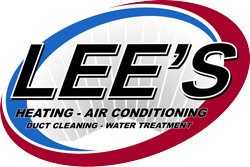While maintaining indoor air quality involves a few basic challenges and solutions throughout the year, the winter period we’re just entering around Utah tends to be the toughest. There are a few reasons why this is typically the case, plus some basic steps you can take to ensure your home’s air quality remains high through the coldest parts of the year.
At Lee’s Heating and Air, we’re here to help with all your HVAC needs around Salt Lake City, Provo, American Fork and nearby areas, including many air quality products or services like air purifiers, air filters, humidifiers and more. Here are some basics on why the colder parts of the year tend to carry the most risks when it comes to poor air quality, plus some pollutant sources to watch out for any some other basic approaches to keep your home’s air quality high and clean.
We Spend More Time Indoors
The first and most notable reason for winter air quality challenges: We simply spend more time indoors during this time of year. This is logical, as temperatures outside aren’t nearly as comfortable and we naturally want to stay warm and cozy inside with our loved ones.
Unfortunately, many indoor pollutants can build up over time if not properly addressed, meaning that the longer we’re indoors without proper ventilation or filtration systems in place, the more we’re exposed to these contaminants.
Outdoor Contaminants
In certain cases, outdoor air quality can also play a role in your indoor air quality during winter. This is particularly true when it comes to inversion conditions that may take place in some parts of Utah – these refer to weather patterns where warm air traps cooler air inside it and holds it close to the ground. The result? Outdoor pollutants like particulate matter, which are usually blown away in more typical weather patterns, can build up and make their way indoors during inversion conditions.
Poor Ventilation
Another key factor in indoor air quality challenges during winter is ventilation, or a lack thereof. Many modern homes are built with tight seals that help keep heat inside – but unfortunately, they also lock in pollutants and contaminants. If you’re not careful about proper ventilation techniques, your home may trap harmful air inside.
Knowing Indoor Pollutant Sources
One important piece of the puzzle when it comes to maintaining air quality is knowing where pollutants may be coming from. Some common sources include:
- Combustion sources: These refer to anything that burns fuel, such as gas stoves or furnaces. Many of these sources produce carbon monoxide, a highly dangerous gas.
- Tobacco smoke: Even for those who don’t smoke indoors, this can be an issue if you live in a multi-unit building or have neighbors who smoke.
- Building materials: There are numerous materials that may produce pollutants over time, from asbestos to lead paint and others. Many older homes contain at least some of these materials, and they can often be sources for pollutants.
- Cleaning supplies: Many cleaning supplies contain volatile organic compounds (VOCs) that can harm air quality. Be sure to use natural alternatives or open windows when cleaning with harsher chemicals.
- Pets: While not pollutants in the traditional sense, pets can produce pet dander and other allergens that may impact air quality if they’re not properly groomed or cleaned up after.
Basic Steps for Cleaner Air
Here are some basic steps you can take to keep your home’s air quality high during winter:
- Replace dirty air filters: These should be replaced at least every 90 days, and more often for homes with smokers or pets.
- Clean regularly: Regular cleaning can help prevent dust buildup and the need for stronger chemicals.
- Invest in an air purifier: These products are designed to remove contaminants from your home’s air and can make a major difference during winter.
- Utilize ventilation techniques: Open windows whenever possible, use vents and fans when cooking or showering, and consider installing a heat recovery ventilator for improved air circulation.
- Have your HVAC system checked: It’s always wise to have an HVAC technician take a look at your system before winter. They can spot any issues that may impact air quality and make repairs or adjustments as needed.
By following these basic tips, you can help ensure your home’s air quality stays high and clean throughout the winter season. And for any additional HVAC needs or questions around SLC, Provo, American Fork or any nearby area, don’t hesitate to contact us at Lee’s Heating and Air. We’re here to help!


